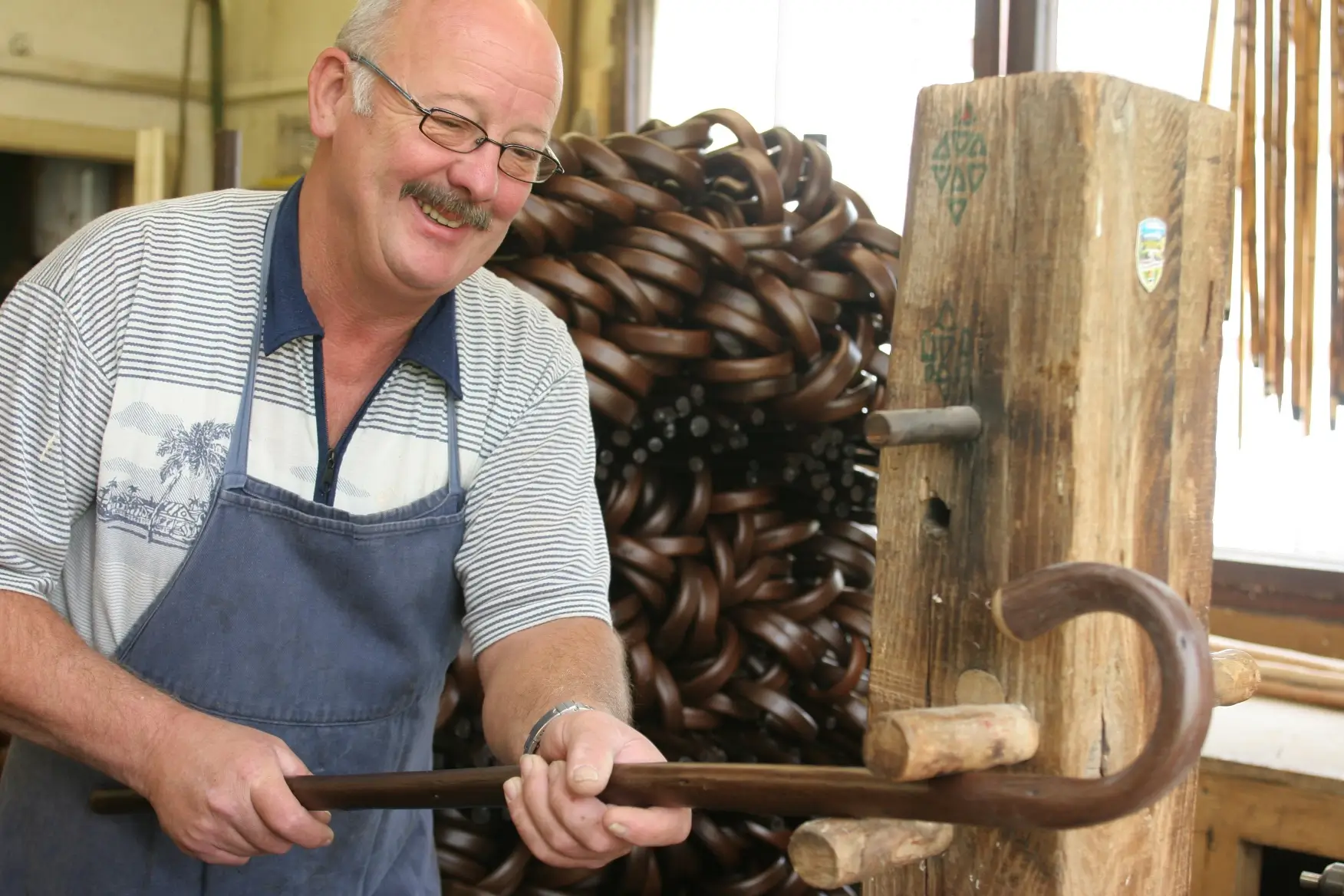Handmade walking sticks blend function with art. These unique pieces show the skill of craftsmen who shape wood into useful tools. Unlike factory-made options, each stick carries a personal touch. They serve hikers, collectors, and those needing support. Many admire the beauty of carved designs or natural wood grains. This guide reveals the charm behind these creations. Learn why so many choose handmade over mass-produced. Discover the stories and effort that make each piece special. Let’s dive into the world of handmade walking sticks and see their true value.
Table Of Contents
The Art of Crafting Handmade Walking Sticks
Craftsmen create handmade walking sticks with great care. They start by choosing the best wood for the job. Popular choices include oak, hickory, and ash. Oak brings strength and a classic look. Hickory offers toughness and flexibility. Ash provides a lightweight with a smooth grain. Artisans pick wood based on durability and beauty.
They shape the wood using specific tools. Knives and chisels help with detailed carving. Many use scorching to add unique dark patterns. Sanding makes the surface smooth to touch. Artisans rely on these methods for quality results.
The process ends with final touches. Craftsmen apply oil or varnish to guard the wood. Some top brands stand out with special techniques. They craft intricate carvings that show fine detail. Others use complex bending methods for distinct shapes. These signature styles make each stick a work of art.
History and Cultural Significance of Walking Sticks

Walking sticks hold a long history across the world. In ancient Egypt, they showed power and rank. Pharaohs carried them as signs of authority. During the Victorian era, they became stylish accessories for the wealthy. People also used them as hidden weapons for protection.
Different cultures shaped walking sticks in unique ways. Shepherds in Europe crafted crooks to guide livestock. African tribes made ceremonial sticks for rituals and leadership. Hikers in Europe relied on sturdy staffs for mountain trails. Each design reflected local needs and traditions.
Today, walking sticks carry new meaning. They still help with balance and support. Many now see them as a way to show personal style. People choose designs that match their tastes or tell a story. Walking sticks blend function with individual expression in modern times.
Discover the benefits, types, and tips for choosing the best walking sticks in our detailed guide, Walking Sticks: Benefits, Types & Tips to Choose the Best. This comprehensive post will help you understand how to select the perfect walking stick to complement your handmade walking stick collection.
Why Choose Handmade Walking Sticks?

Handmade walking sticks offer clear advantages over factory-made ones. They boast superior quality with careful attention to detail. Each piece stands out as one-of-a-kind, unlike mass-produced options. When you buy handmade, you also support skilled artisans and their craft.
These sticks come in a wide range of designs. Many feature nature-inspired carvings like bears, wolves, or flowers. Some showcase intricate patterns or cultural symbols. You can find a style that fits your taste or reflects a personal theme.
Handmade sticks often carry deep emotional value. Custom pieces tell unique stories. Artisans might craft a stick to honor a memory or mark a special event. Owners feel a strong bond with these items. They become treasured keepsakes, not just tools for walking.
How to Choose the Perfect Handmade Walking Stick
Picking the right handmade walking stick takes thought. First, check the height. Stand straight and let your arm hang naturally; the stick should reach your wrist. Next, consider the weight. A lighter stick works for casual walks, while a heavier one offers more support. Look at the grip too. It must feel secure in your hand. Decide the purpose—hiking, daily help, or just for show.
Match the design to your style or need. Choose a rugged stick with tough wood for outdoor trips. Pick an elegant one with fine carvings for formal events. The look should reflect who you are.
Test the stick before you buy it. Hold it and walk a few steps. Feel the balance and stability. Make sure it supports your weight without wobbling. Press down to check if it bends or slips. Comfort matters most, so take your time to find the perfect fit.
Customization and Personalization Options
Creating a custom handmade walking stick starts with connecting to an artisan. Share your ideas clearly. Ask for specific engravings, like names or symbols. Request a particular wood type, such as oak or walnut, for the look you want. Discuss thematic elements, like nature or heritage designs, to make it personal. Artisans often welcome sketches or photos to guide their work.
Popular personalization trends add unique touches. Many choose family crests to honor their roots. Others pick initials for a simple, bold statement. Some request carvings of animals or hobbies that mean something special to them.
Find customizable options through top-ranking sellers. Check platforms like Etsy for skilled craftsmen with high reviews. Look at websites of well-known brands that offer bespoke services. Browse their galleries for inspiration. Reach out directly to discuss your vision and get a quote. These sources often provide the best choices for a one-of-a-kind stick.
Care and Maintenance of Handmade Walking Sticks
Keep your handmade walking stick in top shape with basic care. Wipe it down with a soft, dry cloth to remove dust. Use a damp cloth for stubborn dirt, then dry it right away. Apply wood oil every few months to prevent drying out. Rub the oil in with a clean cloth for even coverage. Shield the stick from extreme heat or cold. Don’t leave it in direct sun or freezing conditions for too long.
Fix small damages yourself if they appear. Smooth out minor scratches with fine sandpaper. Work gently to avoid harming the finish. For deeper nicks, apply wood filler and sand it flat. Refinish the stick if the surface looks worn. Strip old varnish with a mild solvent, then add a fresh coat. Follow the grain for a smooth result.
Store the stick properly to protect its form and look. Hang it upright on a rack or hook. Avoid leaning it against walls for long periods. Keep it in a dry, cool spot away from moisture. Proper storage stops warping and preserves the craftsmanship.
DIY Handmade Walking Sticks – Crafting Your Own
Crafting your own walking stick starts with simple steps for beginners. Head outdoors to find a sturdy branch. Look for straight, thick wood from trees like oak or hickory. Cut the branch to your height—measure from the ground to your wrist while standing. Gather basic tools: a sharp knife, sandpaper, and a saw. You’ll also need wood oil or varnish for the finish.
Begin the process with care. Strip the bark off the branch using your knife. Work slowly to avoid deep cuts in the wood. Shape the top into a comfortable grip. Sand the entire stick until it feels smooth. Add basic carvings if you want detail. Start with simple lines or shapes. Finish by rubbing in wood oil to protect the surface.
Stay safe while crafting. Wear gloves to shield your hands from splinters. Keep your knife sharp for clean cuts. Work in a well-lit space to see every detail. Watch online videos or read beginner guides for extra tips. Check resources like woodworking forums or library books for clear advice.
Find inspiration for unique designs. Look at nature for ideas—carve leaves or animals into the wood. Think about personal touches. Add your initials or a small symbol that means something to you. Paint or stain the stick for extra flair. Make the design reflect your story or style.
Where to Buy Handmade Walking Sticks
Find quality handmade walking sticks at top online stores and marketplaces. Brazos Walking Sticks offers a wide selection with detailed craftsmanship. Their products often feature natural wood designs. Fashionable Canes provides stylish options for both function and flair. Check Etsy for unique pieces from individual artisans. Amazon also lists sellers with handmade sticks, though you must read reviews for authenticity.
Spot authentic handmade products with a few key checks. Look for uneven details or small imperfections—these show handwork. Mass-produced sticks often appear too perfect or uniform. Read product descriptions for terms like “hand-carved” or “ artisan-made.” Ask sellers for photos of the crafting process if you’re unsure. Trust reviews from other buyers for honest feedback.
Expect different price ranges based on craftsmanship. Basic handmade sticks start around $30 to $50. They offer simple designs with decent quality. Mid-range options, between $50 and $100, show more detailed carvings or better wood. High-end sticks, priced over $100, feature intricate work or rare materials. Set your budget and pick a stick that matches the level of detail you want.
Joining the Walking Stick Community
Dive into the walking stick community through online platforms and events. Join forums like the Walking Stick Forum to discuss tips and ideas. Look for Facebook groups focused on handmade canes or hiking gear. Follow Instagram pages where enthusiasts post photos of unique designs. Attend local craft fairs or outdoor expos to meet others who share your interest. For starters, check out communities like Walking Stick Forum or search for relevant groups on Facebook.
Share your stories and designs with people who get it. Post pictures of your walking stick on social media. Write about why it matters to you in group threads. Comment on others’ creations to start conversations. Swap ideas for carvings or finishes. Build friendships with those who value the same hobby.
Connect with artisans to learn or work together. Reach out through their websites or social media profiles. Send a polite message asking for advice on crafting techniques. Join workshops if they offer them. Propose a joint project if you have a specific vision. Show respect for their skills, and they’ll often help or guide you.
Handmade walking sticks blend function with art. They support your stride and showcase unique designs. Measure a walking stick by standing straight and cutting it to wrist height. This ensures a perfect fit for comfort. Buy one or craft your own to feel the skill behind each piece. Share your personal stories or designs below. Join a community to connect with others who value this craft. Show off your stick and inspire fellow enthusiasts with your journey.

Tariqul is a dedicated health and wellness blogger with a background in health sciences. With years of experience in patient education and health communication, he focuses on providing accurate, easy-to-understand information to help readers make informed decisions about their well-being. Passionate about bridging the gap between clinical knowledge and everyday life, Tariqu ensures his content is both practical and medically sound.

